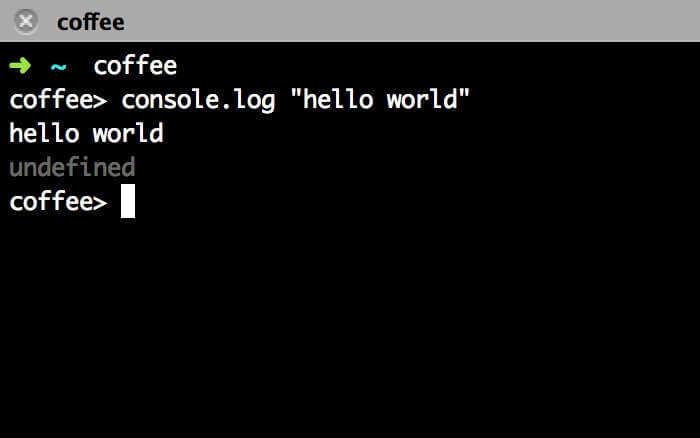CoffeeScript 笔记
最近读了《CoffeeScript程序设计》的前半部分「核心 CoffeeScript」。对 CoffeeScript 也是有了初步的了解,本文只是我的随手笔记,并没有非常系统的总结 CoffeeScript 语法,想学习语法的同学可以看以下两份中文材料:
为什么要用 CoffeeScript?
- 采用了 JavaScript 中的 Good Parts,符合 JS 最佳实践
- 代码简洁清晰,有很多语法糖
一些特性
1.有意义的空格
CoffeeScript 移除了所有的大括号和分号。
JS 会自动在行尾添加;,但它又没有纯粹的设计为一款不需要加分号的语言,所以有时候会引起一些蛋疼的Bug。而 CoffeeScript 会在编译出的 JS 代码里每行都加;,很方便。
CoffeeScript 和 Python、Ruby 一样,采用强制缩进(Coffee的很多地方与 ruby 类似),这种简洁,可读性又很强的代码,让人大爱。
2.变量作用域的控制
JS 中的变量作用域一直让人诟病。
CoffeeScript 把编译生成的 JS 封装在一个匿名函数中:
(function(){
// 这里是编译生成的代码
}).call(this);这样就巧妙避免了全局作用域的污染。同时,CoffeeScript 始终在编译生成的 JS 代码中用 var 声明变量。
3.存在性判断
CoffeeScript 中有个操作符 ?,用于检测变量是否存在。
console.log html if html?这句 CoffeeScript 编译过来为(去掉了匿名封装函数,为了方便,之后的编译后代码都去掉)
if (typeof html !== "undefined" && html !== null) {
console.log(html);
}可见,? 会先检测变量有没有定义,如果定义了再检测是否为 null。
4.函数和 splat 操作符
CoffeeScript 中去掉了 function 关键字。用 () -> 定义一个函数。括号内为参数,可以为参数设置默认值。如:
myFunction = (a, b = 2) ->
a + b编译为:
var myFunction;
myFunction = function(a, b) {
if (b == null) {
b = 2;
}
return a + b;
};调用函数的时候,还可以不用括号。如:
myFunction 3, 5有一点需要注意一下,CoffeeScript 会在编译后的 JS 代码中自动为最后一行添加 return 关键字。所以不论函数的最后一行是什么,都会成为返回值。如果你不想让最后一行成为返回值,就需要另起一行自己加上 return。
splat 操作符非常强大。在你的函数需要接受可变数量的参数时就需要它了。书上的栗子:
splatter = (etc...) ->
console.log "Length: #{etc.length}, Values: #{etc.join(', ')}"
// CoffeeScript 中字符串插值用 #{}
splatter()
splatter("a", "b", "c")
// 输出
Length: 0, Values:
Length: 3, Values: a, b, c就在某个参数后面加上...,就使传入的参数自动转化为一个数组。splat 操作符可以出现在参数列表的任意位置,但是参数列表中只能有一个 splat 操作符。
5.数组与区间
一般定义数组是这样:
myArray = ["a", "b", "c"]在 CoffeeScript 里你还可以这样:
myArray = [
"a"
"b"
"c"
]- 在 JS 中判断是否存在于数组,需要用
Array.prototype.indexOf,在 CoffeeScript 中只需要用in:
console.log "d was not be found" unless "d" in myArray
// 输出
d was not be found- 交换赋值
x = "X"
y = "Y"
[x, y] = [y, x]交换 x、y 的值就这么简单!
- 多重赋值
myArray = ["A", "B", "C", "D"]
[start, middle..., end] = myArray // 可配合 splat 操作符使用
console.log "start: #{start}"
console.log "middle: #{middle}"
console.log "end: #{end}"
// 输出
start: A
middle: B,C
end: D- 区间
区间能让定义包含两个数字之间所有数字的数组变得很容易。
myRange = [1..10]
console.log myRange
// 输出 [ 1, 2, 3, 4, 5, 6, 7, 8, 9, 10 ]如果不想包括结束数值,可以用 ... 代替 ..。
myRange = [10...1]
console.log myRange
// 输出 [ 10, 9, 8, 7, 6, 5, 4, 3, 2 ]常见的数组操作,都可以通过区间完成:
myArray = [1..10]
// 分割数组
part = myArray[0..2]
console.log part
// 输出 [ 1, 2, 3 ]
// 替换数组值
myArray = [1..10]
myArray[4..7] = ["a", "b", "c", "d"]
console.log myArray
// 输出 [ 1, 2, 3, 4, 'a', 'b', 'c', 'd', 9, 10 ]
// 插入值
myArray = [1..10]
myArray[4..-1] = ["a", "b", "c", "d"]
console.log myArray
// 输出 [ 1, 2, 3, 4, 'a', 'b', 'c', 'd', 5, 6, 7, 8, 9, 10 ]6.类和继承
一例胜千言:
class Animal
constructor: (@name) ->
move: (meters) ->
alert @name + " moved #{meters}m."
class Snake extends Animal
move: ->
alert "Slithering..."
super 5
class Horse extends Animal
move: ->
alert "Galloping..."
super 45
sam = new Snake "Sammy the Python"
tom = new Horse "Tommy the Palomino"
sam.move()
tom.move()这是官网的例子,麻麻再也不用担心我在 JS 里使用类和继承了 T_T。
- consturctor 函数为类的构造函数。在
new的时候调用,可以重写它。 ::就和 JS 里的prototype一样
很多语法糖
我对「语法糖」的理解就是让代码的读写更简单。
CoffeeScript 中添加了一些关键字,如 unless when then until do 等。不仅如此,CoffeeScript 引入了很多别名来代替一些关键字:
| 别名 | 对应关键字 |
|---|---|
| is | === |
| isnt | !== |
| not | ! |
| and | && |
| or | || |
| true, yes, on | true |
| false, no, off | false |
| @, this | this |
| of | in |
| in | no JS equivalent |
运用别名和新关键字,使代码读起来就和普通的英文一样。而且 CoffeeScript 还自动为你添加关键字,如函数最后的 return,switch 后自动添加 break(这种符合我们惰性的改进都是伟大的!ヽ( ^∀^)ノ)。
安装及用法
1.安装:
npm install -g coffee-script2.用法:
安装完成后,直接在命令行中输入 coffee,就进入了 CoffeeScript 的 REPL(Read-eval-print-loop) 模式,这是一个可交互的控制台,你可以输入 CoffeeScript 代码立即执行。如图:

也可以用指令编译 CoffeeScript 代码执行(CoffeeScript 代码文件后缀名为 coffee):
coffee -c hello_world.coffee还有一些其他选项,我目前用的最多的是 -o、-p、-w 这三个。
-o 即 --output,设置编译后 JS 文件输出到指定文件夹
-p 即 --print ,直接在终端打印出编译后的 JS 代码
-w 即 --watch,监视文件改变,一有变化就重新执行这条指令
coffee -c hello_world.coffee -o ./js -w搭配起来就可以边写边编译到指定文件夹。
其他
有篇文章《CoffeeScript: The beautiful way to write JavaScript》 ,对 JS 和 CoffeeScript 的论述很中肯。但文中对「什么才是优美的代码」的总结更让人印象深刻:
- beautiful code uses the least amount of code to solve a given problem
- beautiful code is readable and understandable
- beautiful code is achieved not when there is nothing more to add, but when there is nothing left to take away (just like great designs)
- the minimal length is a side-effect of beautiful code and not a goal or a measure
参考文献
CC BY-NC 4.0 © GeekPluxFeeds (RSS)